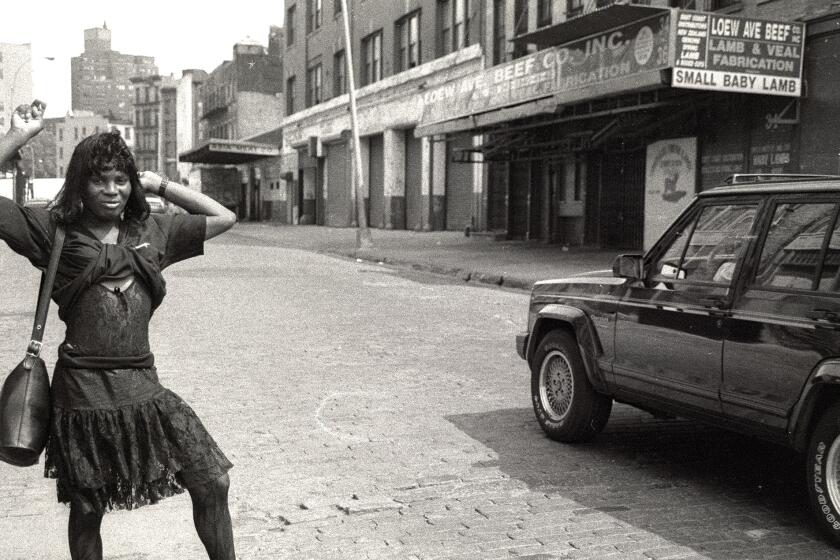He’ll be the last meatpacker in NYC’s Meatpacking District

- Share via
NEW YORK — When John Jobbagy’s grandfather emigrated from Budapest in 1900, he joined a throng of European butchers chopping up and shipping off meat in a loud, smelly corner of Manhattan that New Yorkers called the Meatpacking District.
Today only a few meatpackers remain, and they’re preparing to say goodbye to a very different neighborhood, known more for its high-end boutiques and expensive restaurants than the industry that gave it its name.
Jobbagy and the other tenants in the district’s last meat market have accepted a deal from the city to move out so the building can be redeveloped, the culmination of a decades-long transformation.
“The neighborhood I grew up in is just all memories,” said Jobbagy, 68. “It’s been gone for over 20 years.”
Two of London’s most famous markets are set to close in the coming years, bringing an end to traditions stretching back to medieval times.
In its heyday, it was a gritty hub of more than 200 slaughterhouses and packing plants at the intersection of shipping and train lines, where meat and poultry were unloaded, cut and moved quickly to markets. Now the docks are recreation areas, and an abandoned freight line is the High Line park. The Whitney Museum of American Art moved from Madison Avenue next to Jobbagy’s meat company in 2015.
Some of the new retailers maintain reminders of the neighborhood’s meatpacking past. At the exposed brick entrance to an outlet of fashion brand Rag & Bone, which sells $300 leather belts, is a carefully restored sign from a previous occupant, “Dave’s Quality Veal,” in red and white hand-painted lettering.
Another sign for a wholesale meat supplier appears on a long building awning outside Samsung’s U.S. flagship phone store.
But the neighborhood no longer sounds, smells or feels like the place where Jobbagy began working for his father in the late 1960s. He worked through high school and college summers before going into business for himself.
‘The Stroll,’ premiering Wednesday on HBO and Max, is part of a wave of recent films to reconstruct LGBTQ+ stories from unexpected sources.
Back then, meatpackers kept bottles of whiskey in their lockers to stay warm inside the refrigerated plants. Outside, “it reeked,” he said, especially on hot days near the poultry houses where chicken juices spilled into the streets.
People only visited the neighborhood if they had business, usually transacting in handshake deals, he said.
Slowly but surely, meatpacking plants began closing or moving out of Manhattan as advances in refrigeration and packaging enabled the meat industry to consolidate around packing plants in the Midwest, many of which can butcher and package more than 5,000 steers in a day and ship directly to supermarkets.
Starting in the 1970s, a new nightlife scene emerged as bars and nightclubs moved in, many catering to the LGBTQ+ community. Sex clubs and slaughterhouses coexisted. And as the decades wore on, the drag queens and club kids began giving way to fashion designers and restaurateurs.
Once bustling with city employees, the Civic Center mall has been made desolate by telecommuting options and online access to municipal departments.
By 2000, “Sex and The City” character Samantha had left her Upper East Side apartment for a new home in the Meatpacking District. By the show’s final season in 2003, she was outraged to see a Pottery Barn slated to open near a local leather bar.
Another turning point came with the 2009 opening of the High Line, on a defunct rail track originally built in the 1930s. The popular greenway is now flanked by hotels, galleries and luxury apartment buildings.
Jobbagy said his father died five years before the opening and would be baffled at what it looks like now.
“If I told him that the elevated railroad was going to be turned into a public park, he never would have believed it,” he said.
But the area has changed constantly, noted Andrew Berman, executive director of local architectural preservation group Village Preservation.
Gansevoort Peninsula, the first public beach in Manhattan, is open on an old landfill site along the Hudson River. It’s no California beach, or even a Hamptons beach, but something uniquely New York City.
“It wasn’t always a meatpacking district. It was a sort of wholesale produce district before that, and it was a shipping district before that,” Berman said. In the early 1800s, Fort Gansevoort stood there. “So it’s had many lives and it’s going to continue to have new lives.”
Though an exact eviction date for the last meat market has not been set, some of the other companies will relocate.
Not Jobbagy, who has held on by supplying high-end restaurants and the few retail stores that still want fresh hanging meat. He’ll retire, along with his brother and his employees, most of them Latino immigrants who trained with him and saved up to buy second homes in Honduras, Mexico or the Dominican Republic. Some want to move to other industries, in other states.
He expects to be the last meatpacker standing when the cleaver finally falls on Gansevoort Market.
“I’ll be here when this building closes, when everybody, you know, moves on to something else,” Jobbagy said. “And I’m glad I was part of it and I didn’t leave before.”
Frederick and Attanasio write for the Associated Press.
More to Read
Sign up for Essential California
The most important California stories and recommendations in your inbox every morning.
You may occasionally receive promotional content from the Los Angeles Times.














